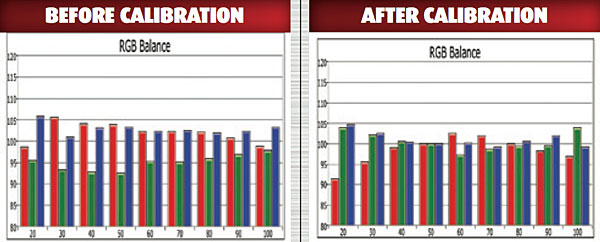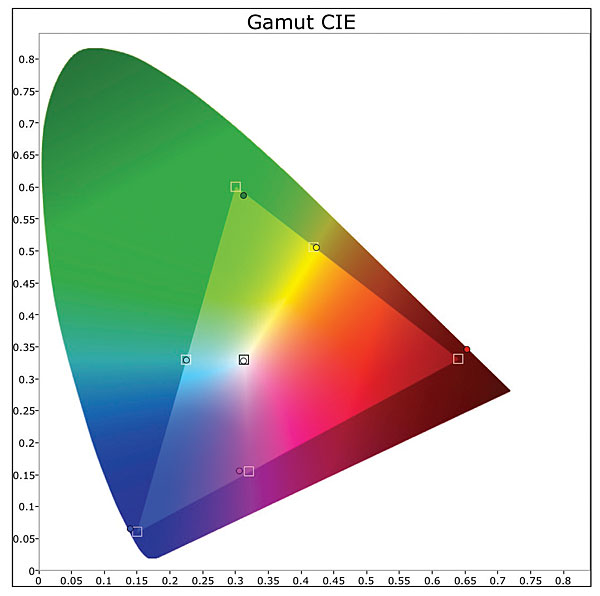Panasonic PT-AE8000U 3D LCD Projector HT Labs Measures
Full-On/Full-Off Contrast Ratio: 5,649:1
All of the testing and viewing was done with over 100 hours on the projection lamp. Except where noted, the measurements presented here are for 2D. The charts shown are for 2D only.
The full-on/full-off contrast ratio above was measured with the projector set up to produce a 96-inch-wide picture on a Stewart StudioTek 130 screen (gain 1.3). The projector-to-screen throw distance for the measurements was approximately 14 feet (for much of the actual watching, it was about 18 feet). The projection lamp was on Normal (as it was for all of the measurements and viewing), the Contrast set to –15, the Brightness to +3, the Gamma to Advanced3, and the Dynamic Iris engaged. The peak white level under these conditions was 20.9 foot-lamberts and the black level 0.0037 ft-L. Turning off the dynamic iris increased the peak white level by about 25 percent at the same control settings while also increasing the black level to approximately 0.008 ft-L.

Color-tracking charts were generated in SpectraCal CalMAN, www.SpectraCal.com
After chasing different setup options, I settled on the Cinema 2 mode for both 2D and 3D. The Before Calibration 2D results were quite watchable, with an average gray-scale Delta E of 3.08 (high 8.27 at 100 percent peak white, under 3.75 at 80 percent and below, and a low of 1.14 at 40 percent) and an average color Delta E of 5.7 (with the highest errors in green and red). The gamma averaged 1.69 (high 2.14 at 40 percent, low 1.1 at 80 percent).
Delta E is a figure of merit showing how close the result is to the standard D65 white point. Most experts re- commend a Delta E value of 4 or less, though some suggest a Delta E of no more than 3 for a visibly ideal result.
After Calibration, the average gray-scale Delta E measured 1.81 (low 0.04 at 50 percent, at or below 2.7 up to 90 percent, and 4.95 at 100 percent peak brightness), and the color Delta E was 5.38. The gamma averaged 1.73. It was just under 2.2 at low brightness levels but decreased progressively above 40 percent to a minimum of 1.16 at 80 percent.

As noted in the review, the measured 3D results, even after much tinkering, were far from ideal. The average gray-scale Delta E measured 7.53. It stayed below 5 up to 70 percent but then rose to a maximum of nearly 18 at 100 percent. The color Delta E averaged just under 5.0 and the gamma a very low 1.12. The peak brightness, measured through the 3D glasses, was 3.23 ft-L. Nevertheless, the result was surprisingly watchable, with the lack of brightness the only visibly obvious shortcoming.

Oddly, the low measured gammas at higher brightness levels in both 2D and 3D never looked peculiar or clearly wrong. They appeared to be related to the functioning of the dynamic iris. With the latter off, the Advanced3 gamma in 2D averaged close to 2.1.—TJN





























































